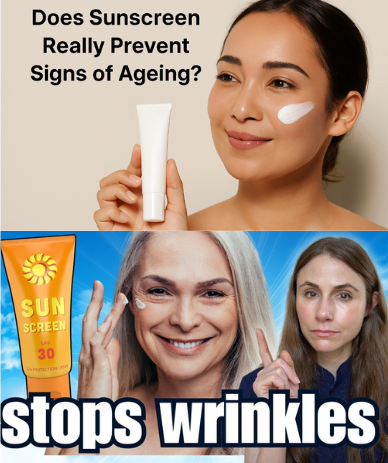
We all crave smooth, youthful skin, yet many people overlook the simplest, most powerful tool sitting right in their bathroom cabinet—sunscreen. It’s often left untouched, waiting to be used, even though it could be the single most important step in preventing wrinkles, fine lines, and dark spots. According to research published by the National Library of Medicine, sunscreen is scientifically proven to protect skin against photoaging—the type of aging caused by UV rays. Put simply: an SPF a day keeps the wrinkles away.
How the Sun Speeds Up Aging
The sun’s rays feel warm and comforting, but they’re also the biggest culprits behind premature skin aging. Chronic exposure to ultraviolet (UV) radiation damages skin cells, breaks down collagen, and accelerates the visible signs of aging.
- UVA Rays (A for Aging)
About 95% of the UV radiation that reaches Earth is UVA. These rays penetrate deep into the skin, damaging collagen and elastin fibers. The result? Wrinkles, sagging, fine lines, and stubborn hyperpigmentation. - UVB Rays (B for Burning)
These rays have more energy and target the skin’s outermost layer. They’re the reason behind sunburns, redness, and in severe cases, skin cancer. While UVA silently ages your skin, UVB burns it—and both types are equally dangerous.
Why Sunscreen is Your Skin’s Armor
So, how do you fight back? By building a protective shield—sunscreen. Sunscreens and sunblocks absorb, scatter, or reflect UV radiation, keeping your skin safe. A broad-spectrum sunscreen ensures you’re covered against both UVA and UVB damage. It’s not just a skincare product—it’s your anti-aging insurance.
Choosing the Best Sunscreen for Anti-Aging
Not all sunscreens are created equal. If your goal is youthful, healthy skin, you need the right one. Here’s what to look for:
Know Your Skin Type
Your sunscreen should work with your skin, not against it. If you have oily or acne-prone skin, choose a non-comedogenic formula that won’t clog pores. For dry skin, opt for hydrating sunscreens enriched with hyaluronic acid or ceramides. Sensitive skin types benefit from mineral sunscreens containing zinc oxide or titanium dioxide.
Broad-Spectrum Protection
Earlier sunscreens only blocked UVB rays, but now, with broader awareness of UVA’s aging effects, most quality sunscreens offer broad-spectrum coverage. This means you’re protected from both burning and aging damage.
Video : Does Sunscreen Really Prevent Wrinkles?
PA Ratings
The PA grading system tells you how well a sunscreen protects against UVA rays. Think of it like a school report card:
- PA+ = Some UVA protection
- PA++ = Moderate protection
- PA+++ = High protection
- PA++++ = The best protection you can get
The more pluses, the stronger your shield against premature aging.
SPF Matters
SPF stands for Sun Protection Factor, and it mostly guards against UVB. Dermatologists recommend SPF 30 or higher for daily use. SPF 30 blocks about 96.5% of UVB rays, while SPF 50 blocks nearly 98%. While no sunscreen offers 100% protection, higher SPF means stronger defense against sunburns and long-term damage.
Water-Resistant Formulas
Heading to the beach or planning to sweat it out at the gym? Choose a water-resistant sunscreen. These formulas hold up better against sweat and water, protecting you for up to 80 minutes before you need to reapply. Without it, your sunscreen could wash right off, leaving your skin exposed.
How to Apply Sunscreen Correctly
Applying sunscreen isn’t just about slapping some on before you leave the house. Technique and consistency matter.
- Quantity: Use at least two tablespoons (about a shot glass) for your face and exposed body parts.
- Frequency: Reapply every 2 hours, especially if you’re outdoors. Indoors? Once in the morning is often enough, but reapply if you’re exposed to windows or screens for long hours.
- Timing: Apply 15–30 minutes before sun exposure to allow the formula to properly bind to your skin.
Do You Need Sunscreen Indoors and on Cloudy Days?
The short answer—yes.
- Cloudy Weather: Up to 80% of UV rays still penetrate through clouds. Just because the sun isn’t visible doesn’t mean your skin isn’t exposed.
- Indoors: Blue light from devices like your phone, laptop, and TV can also accelerate aging. Physical sunscreens with zinc oxide or titanium dioxide offer extra protection from blue light, making them ideal for work-from-home days.
Sunscreen Myths That Need Busting
Let’s face it, many people skip sunscreen because of old myths. Here’s the truth:
- Myth: Darker skin tones don’t need sunscreen.
Fact: While melanin provides some natural protection, it’s not enough to prevent aging or skin cancer. Everyone needs sunscreen. - Myth: Sunscreen is only for summer.
Fact: UV rays are present year-round—even in winter. Snow can reflect up to 80% of UV rays, doubling exposure. - Myth: Makeup with SPF is enough.
Fact: Most makeup products don’t provide enough SPF coverage. Use sunscreen underneath your makeup for true protection.
Video : Daily sunscreen use slows skin aging — even in middle-age
Final Thoughts
The sun gives life, warmth, and energy, but it also speeds up the clock on your skin. Wrinkles, dark spots, fine lines—they’re all signs of photoaging that can be dramatically reduced by one simple habit: wearing sunscreen every day. Think of sunscreen as more than skincare—it’s self-care, protection, and prevention rolled into one.
So the next time you’re tempted to skip it, remember this: sunscreen is the most affordable, effective anti-aging product you’ll ever own. Apply it daily, pair it with a healthy lifestyle, and your skin will thank you with a radiant, youthful glow for years to come.


